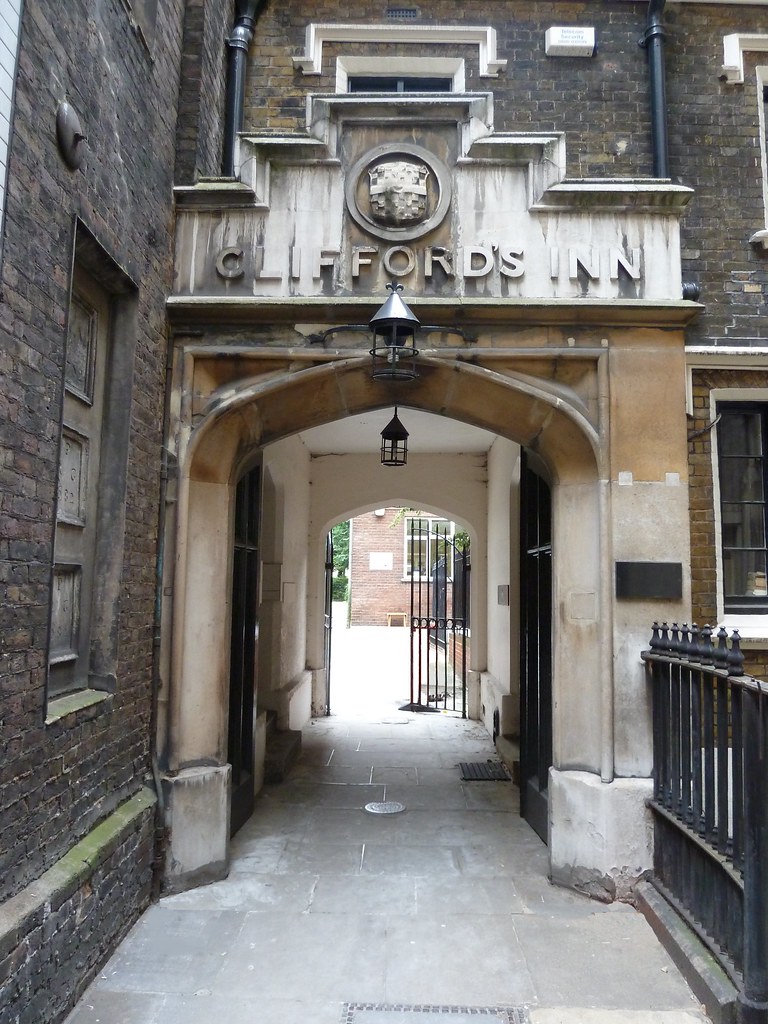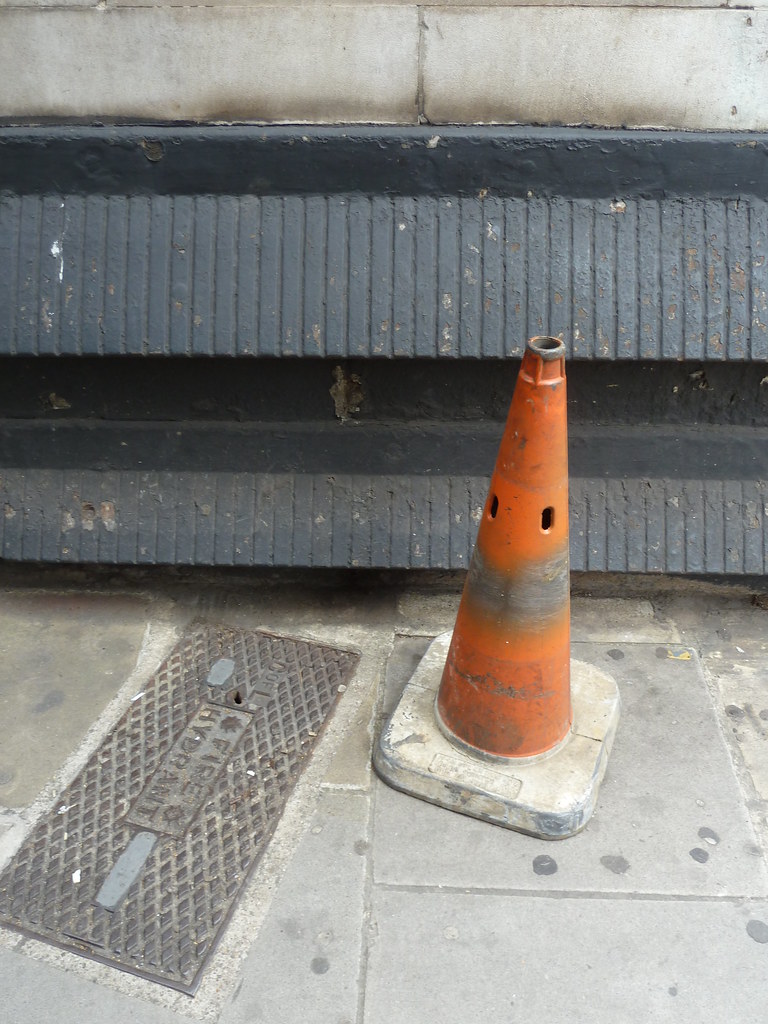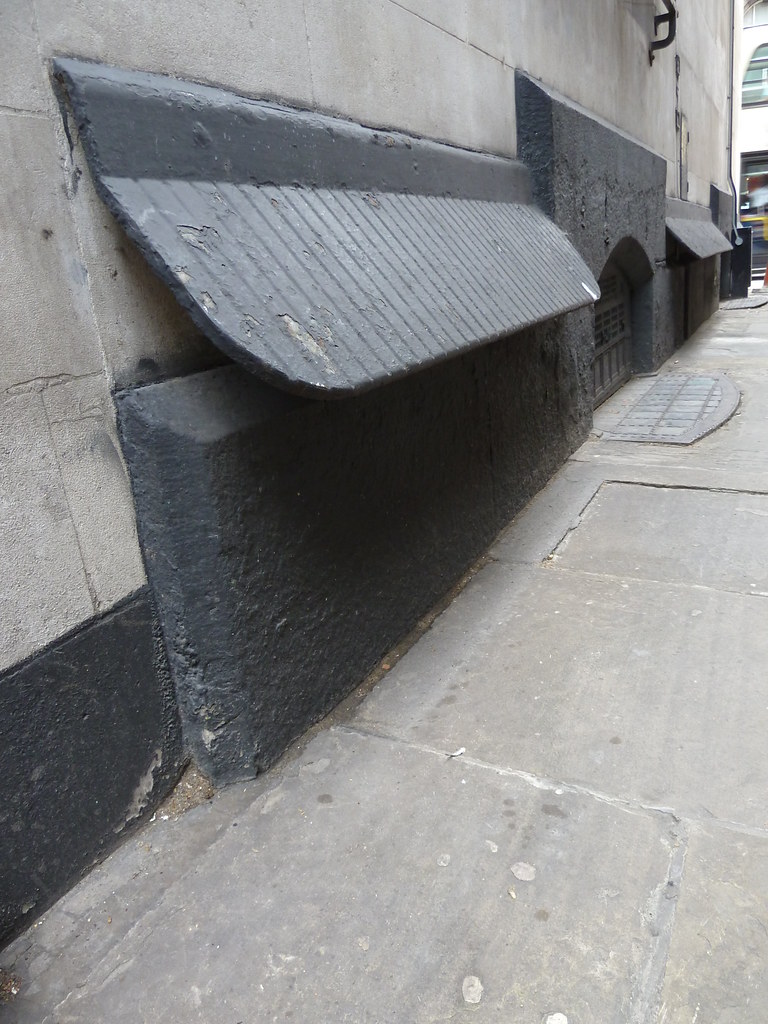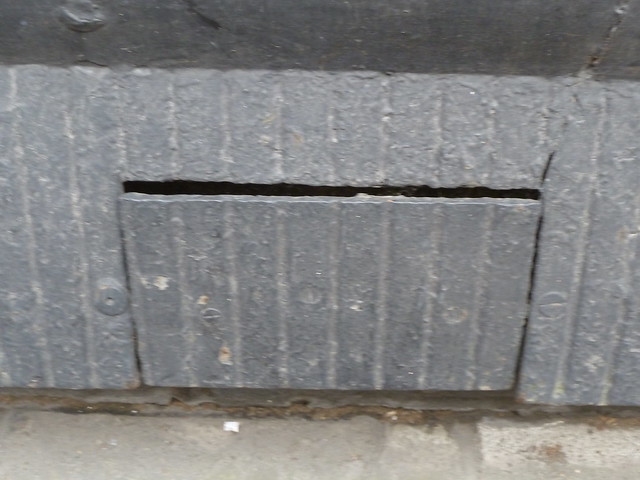
The average (male) Londoner of the early 1800s, out and about, was quite happy to relieve himself in the nearest alley. Urinals were becoming more common - usually outside pubs - but typically one found a quiet corner and had a pee.
Those who lived in said alleys, or who owned commercial property adjoining, were not entirely forgiving of this practice, as this quote from 1809 suggests:
in London a man may sometimes walk a mile before he can meet with a suitable corner; for so unaccomodating are the owners of doorways, passages and angles, that they seem to have exhausted invention in the ridiculous barricadoes and shelves, grooves, and one fixed above another, to conduct the stream into the shoes of the luckless wight who shall dare to profane the intrenchments.
This was the only reference I'd ever seen to these 'barricadoes and shelves' and I wondered if the writer was exaggerating, perhaps just drawing on one or two peculiar examples. Then a few days ago I found a quote from 1853
considering how disgusting are the preventives that disfigure every alley and court, and every piece of blind wall; considering, too, how ineffectual these contrivances are ...
Today, by chance, I walked down Clifford's Inn Passage, off Fleet Street - an ancient bit of London that used to lead to the Inn of Chancery of that name, whose gatehouse still survives. Here, Rokesmith takes Mr. Boffin aside from the bustle of the main thoroughfare in Dickens' Our Mutual Friend. And here, I only now realised - even though I've been here before a hundred times, and even feature it in my Dickens guide-book - was where many a Victorian stopped for a pee.
I remain a bit mystified by this hinged flap in one of the (metal) shelves
I know, you'll now tell that there's a whole website somewhere devoted to 19th century urine deflectors.
I don't care. I think I have discovered something.
But if you can find any more of them, let me know. Keep watching the alleys.
UPDATE: A comparable example in Nottingham
http://www.geograph.org.uk/photo/3320611
Small example on Tower Bridge
http://www.flickr.com/photos/83516580@N03/8122009306/in/photolist-dnHqpd-dnHurj
Chatting with people on twitter, some have asked why only a part of an alley might contain these shelves. In terms of this example, I can't say why there are no flaps over where it looks like there were basement light wells or similar; possibly there were originally, but they were removed when those spaces were filled in; or possibly people just didn't tend to piss where there was a light well.
As for more generally, these would have been deterrents created by the owners of particular buildings, not the parish (at least, I've seen no mention of parishes installing anything like this), so coverage would necessarily be - cough - patchy.
It's also worth noting that building owners weren't necessarily troubled by the impropriety of alley-way urination as much as the damp and the smell ( in a period when 'miasma' was believed to cause disease).
UPDATE II.
Recently noticed this outside the gates to Staple Inn, whose residents were wont to complain to the local vestry about urinating passers-by ... another method ... you would have to stand well back, and therefore you would go somewhere more private. You see these elsewhere in London ... will keep an eye out ...

UPDATE III. (2014)
I'm told the Staple Inn device has been removed during rebuilding work and not replaced. And on a listed building, too!
UPDATE IV. (2015)
Good news! The Staple Inn urine deflectors have been returned to their rightful home.





A brilliant post, thank you. I have a friend who lives in an alley that suffers from this issue. He has a water cannon filled with Dettol that he fires 'at the wall' as the guy is relieving himself 'for hygiene reasons'. If the chap gets soaked in Dettol in the process it is entirely accidental...
ReplyDeleteI believe that these are used to deflect the urine back onto the urinator, as a sort of preventative measure. We have similar (more crude) setups on 19thC houses here in the Black Country, where concrete is bricked up from floor level on houses near pubs - this also gives the opportunity to have run off onto the shoes. Strange but true!
ReplyDeleteCould that hinged thingy possibly be known as a piss flap?
ReplyDeleteDave! Really!! :-)
ReplyDeleteIt's odd that one is "twin level" and also that they didn't continue over the top of the basement window, almost certainly the last place you'd you'd gents of yore relieving themselves.
(See Twitter for another sighting on Tower Bridge)
One of the corners of the Bank of England has a urine deflector (of a different design) built in.
ReplyDeleteFascinating post, something I'd never even dreamed of. And why shouldI? Well, I will look out for some now.
ReplyDeleteWhat a wonderful post. Eyes peeled now for more.
ReplyDeleteFascinating, excellent piece of research, thank you. I'll be looking out for them...
ReplyDeleteIs it me or does the shelf in the second picture seem higher up than the rest? Is it the angle of the picture?
ReplyDeleteYes, just the photo ... they are fairly level in real life.
DeleteVery interesting. Many buildings have as part of their architectural anatomy a feature known as the plinth - the projecting base of a wall. I used to think it was part structural, part decorative, but now I see that it is... defensive.
ReplyDeleteThe NextGen of urine deflectors:
ReplyDeletehttp://www.sfgate.com/bayarea/article/Fifth-anniversary-of-city-s-parklets-more-6130321.php
And now in Shoreditch. http://madeinshoreditch.co.uk/2015/12/16/its-peeback-time-in-shoreditch-and-dalston/
ReplyDeleteIf anyone's interested I am currently mapping Norwich Anti Urination Devices - based on the excellent booklet, "A.U.Ds : An Intimate Study of a Minor Architectural Feature" by Ray Loveday. You can access the map here.
ReplyDeletehttps://drive.google.com/open?id=1yXcuFbk8ZNw_V-KlqybDWV4OAfI&usp=sharing
(The mapping project is incomplete and ongoing.)
Marvellous - I need to get this book!
DeleteThe metal spiky thing, I believe, is also to prevent a mugger from hiding in the corner waiting for a passing victim.
ReplyDeleteYes, I think all of them are for that purpose, to prevent footpads lurking. Erroneously identified as to prevent urination.
DeleteThe one on Staple Inn is not a urine deflector. It's to prevent carriages from impacting the corner. Many of these impacts over time would damage the stonework.
ReplyDeleteI'm not sure (as in genuinely not sure); but you would normally expect a bollard to do that work. The spikes, in particular, would surely play havok with any tall wheel that got stuck on them, and no-one would want a crippled heavy wagon stuck in their gateway.
ReplyDeleteHi! In wich source did you get the quotes? Thanks
ReplyDeleteSee my book Dirty Old London; the sources are in there.
DeleteJust read this - marvellous. Many pubs here in Somerset have what look like buttresses at the base of the door jambs. I have always been told they are urine deflectors
ReplyDeleteHey there, I'm writing a paper on some architectural features and was wondering if you'd be able to link a source to the 1809 and 1853 quotes about the urine deflectors? No worries if not as I am aware it's been over a decade since the post. Thank you in advance :)
ReplyDeleteयूरिनरी ट्रैक्ट इन्फेक्शन या यूरिन इंफेक्शन महिलाओं में सबसे आम हैं। यह पुरुषों की अपेक्षा महिलाओं में अधिक आम है। 50% महिलाओं को अपने जीवन में कम से कम एक बार मूत्र मार्ग में संक्रमण होता है। लगभग एक तिहाई किशोरियों में संक्रमण होने की पूरी संभावना होती है। आवश्यकतानुसार पानी न पीने पर बार-बार यूरिन इंफेक्शन का खतरा बना रहता है।
ReplyDeleteurine infection kya hota hai